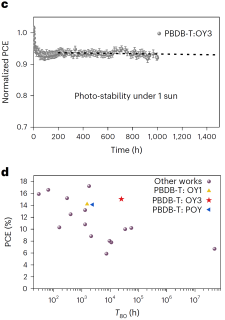Short chains for a long life – Difey optimise performance and stability of multilayer organic solar cells
When it comes to choosing the perfect material for the semiconductor layers, research faces a dilemma: “If we use polymers with very long molecular chains, for example, the module is robust against temperature influences and durable for a long time,” says Prof. Dr. Christoph Brabec. “However, polymers are not as well defined and have more defects due to their complexity, which can lead to poorer power output in low light.” At HI ERN, more research is therefore being done on an alternative for electron transfer: so-called oligomers. Their chains are shorter, they can be designed precisely and their efficiency in near-infrared light is much better than that of polymers. The disadvantage: oligomers are more temperature-sensitive and generally more unstable.
Therefore we choose to combine the best of both worlds – low-molecular non-fullerene semiconductors that have a high power yield and are robust and durable at the same time. “We modified non-fullerene acceptor Y6 in countless experiments and investigated its properties in binary OSCs,” explains Difei Zhang, a doctoral student who conducted the experiments at FAU. During the investigations – researchers from the South China University of Technology (SCUT) were also involved in the study – two-dimensional wide-angle X-ray scattering measurements were used, for example, to analyse the microstructure and behaviour of the molecular chains.
The winner is: OY3
“OY3 has an average power efficiency of 15 percent – a value we also measured for some other derivatives,” says Christoph Brabec. “What impressed us beyond that is the excellent photostability.” Thus, the oligomer still showed 94 percent of its initial performance after 200 hours of operation. Further measurements revealed a lifetime of more than 25000 operating hours – with an average operation of 1500 hours per year, this means a lifetime of more than 16 years.
Christoph Brabec: “These parameters are so far unique for multi-layer organic photovoltaic modules and fulfil all requirements for rapid commercialisation. Our strategy of targeted oligomer design takes organic photovoltaics to a new level of efficiency and brings it very close to practical application.”
Acceptor layers made of oligomers can increase the performance of organic solar cells and at the same time guarantee a long service life. Organic solar cells are easier to produce than conventional silicon modules and at the same time can be used much more flexibly because they can be bendable and transparent, for example. The reuslts are published in Nature Energy.

